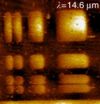(Press-News.org) CAMBRIDGE, Mass. -- A Harvard bioengineer and an MIT aeronautical engineer have created a new device that can detect single cancer cells in a blood sample, potentially allowing doctors to quickly determine whether cancer has spread from its original site.
The microfluidic device, described in the March 17 online edition of the journal Small, is about the size of a dime, and could also detect viruses such as HIV. It could eventually be developed into low-cost tests for doctors to use in developing countries where expensive diagnostic equipment is hard to come by, says Mehmet Toner, professor of biomedical engineering at Harvard Medical School and a member of the Harvard-MIT Division of Health Sciences and Technology.
Toner built an earlier version of the device four years ago. In that original version, blood taken from a patient flows past tens of thousands of tiny silicon posts coated with antibodies that stick to tumor cells. Any cancer cells that touch the posts become trapped. However, some cells might never encounter the posts at all.
Toner thought if the posts were porous instead of solid, cells could flow right through them, making it more likely they would stick. To achieve that, he enlisted the help of Brian Wardle, an MIT associate professor of aeronautics and astronautics, and an expert in designing nano-engineered advanced composite materials to make stronger aircraft parts.
Out of that collaboration came the new microfluidic device, studded with carbon nanotubes, that collects cancer cells eight times better than the original version.
Circulating tumor cells (cancer cells that have broken free from the original tumor) are normally very hard to detect, because there are so few of them — usually only several cells per 1-milliliter sample of blood, which can contain tens of billions of normal blood cells. However, detecting these breakaway cells is an important way to determine whether a cancer has metastasized.
"Of all deaths from cancer, 90 percent are not the result of cancer at the primary site. They're from tumors that spread from the original site," Wardle says.
When designing advanced materials, Wardle often uses carbon nanotubes — tiny, hollow cylinders whose walls are lattices of carbon atoms. Assemblies of the tubes are highly porous: A forest of carbon nanotubes, which contains 10 billion to 100 billion carbon nanotubes per square centimeter, is less than 1 percent carbon and 99 percent air. This leaves plenty of space for fluid to flow through.
The MIT/Harvard team placed various geometries of carbon nanotube forest into the microfluidic device. As in the original device, the surface of each tube can be decorated with antibodies specific to cancer cells. However, because the fluid can go through the forest geometries as well as around them, there is much greater opportunity for the target cells or particles to get caught.
The researchers can customize the device by attaching different antibodies to the nanotubes' surfaces. Changing the spacing between the nanotube geometric features also allows them to capture different sized objects — from tumor cells, about a micron in diameter, down to viruses, which are only 40 nm.
The researchers are now beginning to work on tailoring the device for HIV diagnosis. Toner's original cancer-cell-detecting device is now being tested in several hospitals and may be commercially available within the next few years.
###
MIT: New blood-testing device can quickly spot cancer cells, HIV
2011-03-30
ELSE PRESS RELEASES FROM THIS DATE:
Skills training can improve responses to disclosures of trauma
2011-03-30
EUGENE, Ore. -- (March 29, 2011) -- New research from the University of Oregon concludes that even brief training can help people learn how to be more supportive when friends and family members disclose traumatic events and other experiences of mistreatment.
"The Impact of Skills Training on Responses to the Disclosure of Mistreatment," by Melissa Ming Foynes and Jennifer J. Freyd was published in the inaugural issue of the new American Psychological Association journal, Psychology of Violence. The study examined the effectiveness of skills training to enhance supportive ...
Satellites show effect of 2010 drought on Amazon forests
2011-03-30
WASHINGTON—A new study has revealed widespread reductions in the greenness of Amazon forests caused by the last year's record-breaking drought.
"The greenness levels of Amazonian vegetation -- a measure of its health -- decreased dramatically over an area more than three and one-half times the size of Texas and did not recover to normal levels, even after the drought ended in late October 2010," says Liang Xu of Boston University and the study's lead author.
The drought sensitivity of Amazon rainforests is a subject of intense study. Computer models predict that in ...
Berkeley Lab researchers make first perovskite-based superlens for the infrared
2011-03-30
Superlenses earned their superlative by being able to capture the "evanescent" light waves that blossom close to an illuminated surface and never travel far enough to be "seen" by a conventional lens. Superlenses hold enormous potential in a range of applications, depending upon the form of light they capture, but their use has been limited because most have been made from elaborate artificial constructs known as metamaterials. The unique optical properties of metamaterials, which include the ability to bend light backwards - a property known as negative refraction - arise ...
Fitness tests for frogs?
2011-03-30
Durham, NC —The most toxic, brightly colored members of the poison frog family may also be the best athletes, says a new study.
So-named because some tribes use their skin secretions to poison their darts, the poison dart frogs of the Amazon jungle are well known for their bitter taste and beautiful colors. The spectacular hues of these forest frogs serve to broadcast their built-in chemical weapons: skin secretions containing nasty toxins called alkaloids. Like the red, yellow and black bands on a coral snake or the yellow stripes on a wasp, their contrasting color ...
Bigmouthmedia Shortlisted for the Highly-Respected a4u Awards 2011
2011-03-30
Digital marketing company bigmouthmedia has been shortlisted by judges for the award of Best Agency in recognition of the innovative and dynamic approach taken to campaigns by the Performance Marketing team on behalf of clients.
Nomination in such a highly competitive category in the a4u Awards 2011, alongside industry heavyweights including 7thingsmedia, Arena Quantum and Stream 20, is sound acknowledgment of bigmouthmedia's position at the forefront of performance marketing. Bigmouthmedia's performance marketing team delivers for its clients successful campaigns integrated ...
PuckProspect.com Hockey Scouting and Recruiting Website the Best Do It Yourself Hockey Recruiting Tool
2011-03-30
Newest Hockey Recruiting and Hockey Scouting Service redefines old methods.
When Jerry Maguire pleaded "Help Me, Help You!" no one had any idea this phrase would resonate from football to hockey. But it has through an innovative online hockey recruiting and hockey scouting service called PuckProspect.com where hockey players are taking full advantage by helping themselves get noticed.
The concept of hockey players marketing themselves is relatively new compared to the old hockey recruiting and hockey scouting models. PuckProspect.com lets hockey players work smarter ...
Stanford researchers use river water and salty ocean water to generate electricity
2011-03-30
Stanford researchers have developed a battery that takes advantage of the difference in salinity between freshwater and seawater to produce electricity.
Anywhere freshwater enters the sea, such as river mouths or estuaries, could be potential sites for a power plant using such a battery, said Yi Cui, associate professor of materials science and engineering, who led the research team.
The theoretical limiting factor, he said, is the amount of freshwater available. "We actually have an infinite amount of ocean water; unfortunately we don't have an infinite amount of freshwater," ...
Soft Refurbishment at the Millennium Suite, Copthorne Hotel London Gatwick & Copthorne Hotel Effingham Gatwick
2011-03-30
The Millennium Suite, shared by both Copthorne Hotel London Gatwick and Copthorne Hotel Effingham Gatwick has recently undergone a soft refurbishment. Occupying approximately 1,126 square metres with a maximum capacity of 650 guests, the Millennium Suite is undoubtedly one of the largest meetings and event venues in the area and an ideal option if you're looking for hotels near Gatwick airport.
Featuring a new beige patterned carpet and curtains in a neutral shade of beige to lighten the venue's space, the modern Millennium Suite ensures that events can accommodate any ...
Older lesbians, gays have higher rates of chronic disease, mental distress, isolation
2011-03-30
Members of California's aging lesbian, gay and bisexual population are more likely to suffer from certain chronic conditions, even as they wrestle with the challenges of living alone in far higher numbers than the heterosexual population, according to new policy brief from the UCLA Center for Health Policy Research.
Half of all gay and bisexual adult men in California between the ages of 50 and 70 are living alone, compared with 13.4 percent of heterosexual men in the same age group. And although older California lesbians and bisexual women are more likely to live with ...
What choice do we have?
2011-03-30
Too much choice can be a bad thing—not just for the individual, but for society. Thinking about choices makes people less sympathetic to others and less likely to support policies that help people, according to a study published in an upcoming issue of Psychological Science, a journal of the Association for Psychological Science.
In the U.S., important policy debates are often framed in terms of choice, such as whether people get to choose their own healthcare plan and a school for their children. "When Hurricane Katrina happened, people asked, why did those people choose ...



